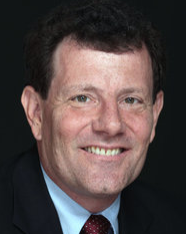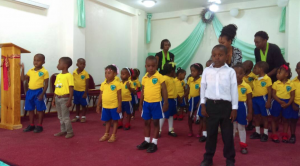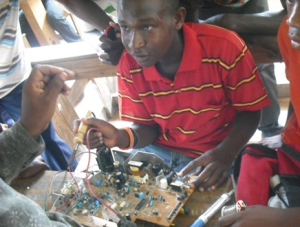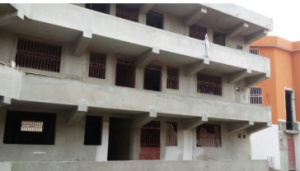
By NICHOLAS D. KRISTOF
Published: December 7, 2013 New York Times

PORT-AU-PRINCE, Haiti — ALMOST four years after the earthquake that devastated Haiti, Darline St. Luc, 13, is one of the hundreds of thousands of people who are still homeless. She and her family get by in a leaky, rat-infested shack made out of old USAID grain sacks, and she says that she sometimes goes days without eating.
It has been months since Darline had a bite of meat, and she says she doesn’t quite remember what an egg tastes like. Her dad died this year, and she had to drop out of school in September because she couldn’t afford the $200 needed for a school uniform, shoes, books and supplies.
Yet, this month, Darline is back in school because of an extraordinary Haitian woman who has turned a torture chamber into a school — backed by high school students from Los Altos, Calif., who raised money for it.
Let’s acknowledge that Haiti is Exhibit A for many people who think that foreign aid is, in the words of the late Senator Jesse Helms, “money down a rathole.” Billions of dollars have poured into this country and countless aid workers drive around in white S.U.V.’s, yet Haiti remains the poorest country in the hemisphere.
Angus Deaton, a development economist at Princeton University, says that he began his career believing in foreign aid but gradually came to conclude that it is unhelpful and even harmful. In a new book, “The Great Escape,” Deaton suggests that aid fuels corruption without improving economic growth. Referring to aid workers, he concludes: “Dedicated and ethical people are doing harm.”
I disagree, but this is an important argument to have because so much rides on it. And a starting point is to acknowledge that aid sometimes wasn’t effective because it was intended mostly to prop up allies, or to support American businesses. Deaton says that some 70 percent of aid from the United States may never reach the recipient country, at least in cash — so it’s not surprising that it doesn’t always bolster the lives of Haitians like Darline.
More broadly, whether or not aid boosts economic growth, it unquestionably saves lives. Haiti’s infant mortality rate has been nearly halved since the 1990s. Worldwide as well, aid has dramatically reduced child deaths and, after a lag, brought down birthrates, too. Here in Haiti, women average 3.3 babies today, down from around 6 in the 1980s.
Aid’s impact on economic growth is more complicated. But there is reason to think that as people become educated and better nourished they will become more productive and demand better economic governance, laying the foundation for improved growth rates.
And if Haiti is Exhibit A for skeptics, it’s worth noting that Haiti may be on the move again. The economy is growing faster than America’s, kidnappings are down and new garment factories are reviving the manufacturing sector. And Haitians themselves are stepping up to build their own aid networks for girls like Darline — because they see that the right kind of aid can achieve remarkable returns.
The school that Darline attends was founded by Rea Dol, 46, who grew up impoverished in the Haitian countryside. Dol dropped out of school in the eighth grade, then returned to school in fits and starts. Eventually Dol started a literacy program and then a school housed in a former secret police base with a torture chamber.
This school, called the SOPUDEP school after a local community organization that supports it, now serves 835 low-income children from prekindergarten through 12th grade. Dol asks for school fees from those who can pay, but, when there’s no money, she sometimes waives the fee and even provides a free uniform and books.
The school is an exemplary marriage of local leadership and foreign donors. A Canadian foundation has been very supportive, and Dol once ran into Seth Donnelly, a Los Altos High School teacher, in a Haiti guesthouse. That led Los Altos students to raise $200,000, allowing Dol to take over two other schools in Haiti and start building a big new one.
Helping people is harder than it looks, whether for Dol or for international aid groups. After the earthquake, Canadian supporters sent her a 20-foot shipping container of books and clothing, but Haitian customs officials seized it, held the container for a year, and then charged $15,000 for duty and storage fees — a sum that donors had to make up.
Yet Dol soldiers on and works closely with a network of other Haitians also trying to build a better Haiti. She delivered some of the books to support a new library for Sakala, a program that promotes education in a notorious slum called Cité Soleil.
Daniel Tillias, a Haitian who leads Sakala, says that the library shows that local people can solve their own problems and overcome an aid-driven culture of dependency and passivity.
“People say, ‘why should we build a library? Unicef should do it for us,’ ” Tillias said. “People need to understand that the only person who can build a better life for you is yourself.”
DARLINE still faces enormous challenges. She has never seen a doctor or a dentist in her life. Rats scurry around her home and the public outhouses. And now that she is 13, men harass her; she worries that in the insecurity of the crime-ridden makeshift encampment where she lives, she may be raped, as two of her sisters were.
“When I go to the toilet, men are scarier than the rats,” Darline said. “I can kill the rats, but I can’t kill the men.”
In this bleak environment, school offers a ray of hope for a better future. Darline eats a free meal every day at school, so her nutrition improves and she’s less anemic.
I was there in her hut when Dol handed Darline a school uniform and told the family that she could return to school. The family lit up with joy, and Darline is now dreaming of graduating from high school, maybe even going to college through a university fund that Dol has established at SOPUDEP.org.
Now five other children living near Darline have trooped to the school to see if they, too, can get a free education. Dol is scrambling to find the money to make that happen — because anyone in this slum sees that the right kind of aid can, indeed, transform a child’s life.
I invite you to comment on this column on my blog, On the Ground. Please also join me on Facebook and Google+, watch my YouTube videos and follow me on Twitter.


